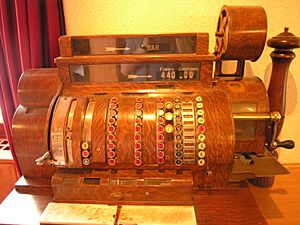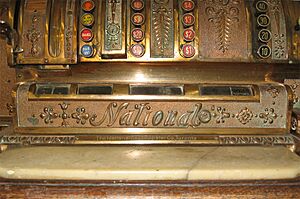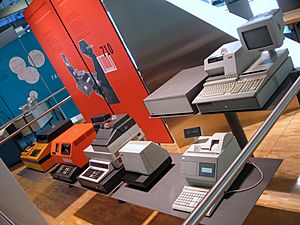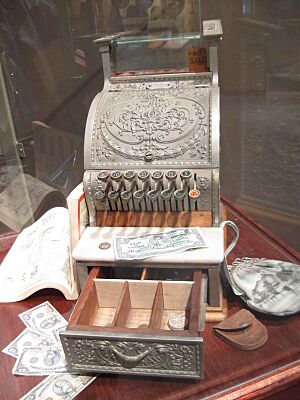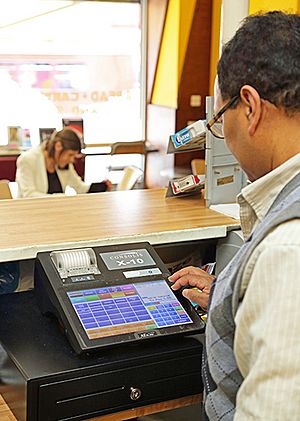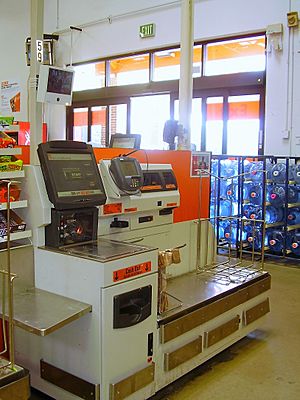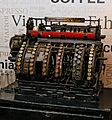Cash register facts for kids
A cash register or till is a machine that helps stores and businesses handle money and keep track of sales. It's usually connected to a drawer where cash and other valuable items are kept safe. Most modern cash registers also have a printer that can give you a receipt for your purchase.
Contents
History of Cash Registers
The first mechanical cash register was invented by James Ritty and John Birch after the American Civil War. James Ritty owned a saloon in Dayton, Ohio, USA. He wanted to find a way to stop his employees from taking money from the business without permission.
In 1879, James Ritty got the idea for his invention after seeing a tool that counted how many times a propeller turned on a steamship. With help from his brother John Ritty, they patented their invention in 1883. They called it Ritty's Incorruptible Cashier. It was designed to prevent employees from stealing money.
Early cash registers were fully mechanical. They didn't print receipts. When an employee entered a sale and pressed the total button, the cash drawer would open, and a bell would ring. This bell let the manager know that a sale was happening. These first machines were basically simple adding machines.
Some people believe that "odd pricing," like charging $4.99 instead of $5.00, became popular because it forced the cashier to open the till to give back the penny change. This made sure the sale was recorded and the manager heard the bell.
Soon after getting the patent, James Ritty sold his cash register business to Jacob H. Eckert. Eckert then sold it to John H. Patterson in 1884. Patterson renamed the company the National Cash Register Company. He made a big improvement by adding a paper roll to record sales. This created a "journal" for the business to keep its own records and a "receipt" for the customer. The receipt helped prevent fraud because the business owner could check if cashiers were charging the right amounts. It also protected the business from customers falsely claiming they received less change.
In 1906, an inventor named Charles F. Kettering, who worked at the National Cash Register company, designed a cash register that used an electric motor.
From the 1950s to the 1970s, a company called Gross Cash Registers Ltd. in London was a major maker of cash registers. Their machines were very popular, especially around 1971 when Britain switched to a new money system (decimalisation). Henry Gross designed a special cash register that could easily switch between the old and new currencies.
Modern Cash Registers
Today, cash registers are often connected to other devices like scales, barcode scanners, and machines for debit card or credit card payments. More and more, special cash registers are being replaced by regular computers that run special "Point of Sale" (POS) software.
Modern POS systems can do many things:
- Scan barcodes (like EAN or UPC) for each item.
- Find the price from a database.
- Calculate discounts for items on sale.
- Figure out sales tax or VAT.
- Update how much of each item is left in the store's inventory.
- Record the exact time and date of the sale.
- Keep track of every item bought and how it was paid for.
- Keep totals for each product and for all sales over certain periods.
These POS systems often print the cashier's name on the receipt and might even include special offers. Many modern cash registers are individual computers, some with touch screens. They can be connected to networks, allowing businesses to check records or fix problems from far away. Many businesses also use tablet computers with special apps as cash registers.
Cash Drawer Details
Cash registers have a button called "No Sale" (or "NS"). This button opens the cash drawer without recording a sale. It's used if a cashier needs to give correct change or get change from another register. Some registers require a password or a special key to open the drawer.
The cash drawer is usually a strong compartment under the cash register. It contains a removable tray, called a "till," which is divided into sections for different types of money (bills and coins). This makes counting money easier. The removable till allows money to be moved to a safer place for counting and preparing bank deposits.
When a cash sale is finished, the register sends an electrical signal to open the drawer. Many cash drawers have a manual release underneath in case the power goes out. Newer ones might have a lock that needs a key to open manually.
Some cash drawers are designed to hold bills upright and facing forward. This allows cashiers to access each bill faster and store more types of bills. Some drawers are "flip-top," meaning they open upwards like a box instead of sliding out.
Manager Functions
Besides the "no sale" function, managers often have special keys to access other functions. For example, they can program prices into the register. They can also get "X" reports, which show current sales figures without resetting them, or "Z" reports, which show sales and then reset the counters to zero.
How Cashiers Input Sales
Cashiers use different ways to enter products and prices. This can be a number pad, a regular keyboard (like a QWERTY keyboard), a touch screen, or a mix of these. For older registers or places like restaurants that don't sell barcoded items, manual input might be the only way to use the register. With touch screens, businesses can easily customize how the input looks and works.
Scanners for Speed
Modern cash registers often connect to a handheld or built-in barcode reader. This allows purchases to be scanned much faster than typing numbers by hand. Scanners also help prevent mistakes. In grocery stores, the scanner might be combined with a scale to weigh items sold by weight.
Receipt Printers
Cashiers usually give customers a receipt after a purchase. Registers typically use thermal printers for receipts, which use heat to print. Older stores might still use dot matrix printers. Some stores can even send receipts by email instead of printing them. Receipts from larger stores often have special barcodes or information that makes returns easier.
Security Deactivation
Stores that use electronic article surveillance (EAS) often have a special pad at the register. This pad deactivates security tags on items as they are purchased. This stops the security alarms from going off when a customer leaves the store.
Self-Service Checkouts
Many stores and supermarkets now have self-checkout machines. Here, customers scan their own items (or manually identify things like fruit) and place them in a bagging area. The machine weighs the items to make sure they match what was scanned. If something doesn't match, the machine stops. Usually, an employee watches over several self-checkouts to help customers and prevent mistakes or theft.
These machines accept debit cards, credit cards, cash (coins and bills), and sometimes other payment methods. Store employees are also needed to approve purchases for things like alcohol or knives, which have age restrictions.
Images for kids
-
Modern point-of-sale system with stationary barcode scanner below the monitor, installed at NSK Trade City branch in Kota Damansara, Malaysia.
See also
 In Spanish: Caja registradora para niños
In Spanish: Caja registradora para niños



